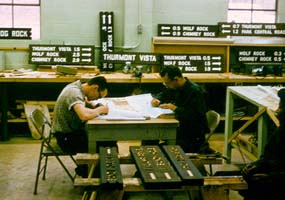To provide observations and information on the emerging fields of landscape scale conservation, heritage preservation, and sustainable community development.
Newsletter
Stay up-to-date with the latest nature, culture and community news.
We won’t spam you or share your information. Newsletters are sent approximately 10 times a year. Unsubscribe at any time.
Theater Production Tells Story of Birth of First Women’s Labor Union
The Riverspark Heritage Area in New York was among the first urban parks in the nation to protect and interpret the history and built environment of labor in the United States. Among the stories and sites preserved was that of Kate Mullany, a young Irish immigrant who led a week long strike in 1864 that gained collar workers in Troy a 25% increase in their wages. Learn more about efforts to place her make her home a National Historic Landmark.
Digital Landscapes
Can new digital technologies aid in the documentation, interpretation, and protection of large landscapes? Below are a few interesting projects and tools from around the web that seek to do just that.
Blackstone River Valley National Heritage Corridor Seeking New Executive Director
The Blackstone River Valley National Heritage Corridor, Inc. (Blackstone) seeks an Executive Director. Established in 2010, Blackstone is a Massachusetts non-profit corporation governed by a

#NHA30: Tales from the Towpaths
National Heritage Areas are conserving roughly a 1,000 miles of canal corridors across the country. These historic waterways and towpaths are becoming tomorrow’s network of trails and blue ways, connecting population centers to parks and historical sites of national, state, and local importance. Find out more the partnership model of management and the entrepreneurial strategies key to NHA success in this guess post.

Observing the War on Poverty on the Landscape
Fifty years ago, President Lyndon B. Johnson declared a “War on Poverty.” How did the many programs associated with this effort shape the material, social and political landscapes of the United States? What can a National Park, home to the nation’s first Job Corps site in 1965, reveal about the legacies, both individual and collective, of the War on Poverty? Guest observer Angela Sirna offers her observations on these complex questions.
Theater Production Tells Story of Birth of First Women’s Labor Union
The Riverspark Heritage Area in New York was among the first urban parks in the nation to protect and interpret the history and built environment of labor in the United States. Among the stories and sites preserved was that of Kate Mullany, a young Irish immigrant who led a week long strike in 1864 that gained collar workers in Troy a 25% increase in their wages. Learn more about efforts to place her make her home a National Historic Landmark.
Digital Landscapes
Can new digital technologies aid in the documentation, interpretation, and protection of large landscapes? Below are a few interesting projects and tools from around the web that seek to do just that.
Blackstone River Valley National Heritage Corridor Seeking New Executive Director
The Blackstone River Valley National Heritage Corridor, Inc. (Blackstone) seeks an Executive Director. Established in 2010, Blackstone is a Massachusetts non-profit corporation governed by a

#NHA30: Tales from the Towpaths
National Heritage Areas are conserving roughly a 1,000 miles of canal corridors across the country. These historic waterways and towpaths are becoming tomorrow’s network of trails and blue ways, connecting population centers to parks and historical sites of national, state, and local importance. Find out more the partnership model of management and the entrepreneurial strategies key to NHA success in this guess post.

Observing the War on Poverty on the Landscape
Fifty years ago, President Lyndon B. Johnson declared a “War on Poverty.” How did the many programs associated with this effort shape the material, social and political landscapes of the United States? What can a National Park, home to the nation’s first Job Corps site in 1965, reveal about the legacies, both individual and collective, of the War on Poverty? Guest observer Angela Sirna offers her observations on these complex questions.


